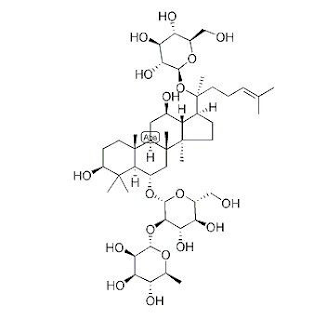An active substance extracted from the dried roots of Araliaceae ginseng, which belongs to tetracyclic triterpenoid saponins, has central nervous system inhibition and stability.

Pharmacological action
Soluble in water, methanol, ethanol, insoluble in ether, benzene. Ginseng has great vitality, nourishing and strengthening, soothing and sorrowing, and other effects. Modern medicine generally believes that ginseng has a wide range of effects on the central nervous system, cardiovascular system, digestive system, immune system, endocrine system, genitourinary system, which can improve the ability of human body and intelligence, and enhance the body's non-specificity to noxious stimuli. resistance. The pharmacological activity of ginseng is often caused by the two-way function of the body's functional state. Therefore, ginseng is a typical representative drug with the function of “adapting to the original.
Usage: Chromatographic conditions and system suitability test: 1 UV detector; wavelength 203nm; flow rate 1ml / min; column: C18 4.6 * 250mm hypersil 2 evaporative light color detector; flow rate 1ml / min; column: Diamonsil C18 4.6*250mm mobile phase: acetonitrile (A), 0.05% phosphoric acid aqueous solution (B) A: B=30:70 (for reference only)
Storage method: 2-8 ° C, protected from light
Precautions:
This product should be stored at low temperature, and the content will be reduced when exposed to air for a long time.
Impact on the cardiovascular system
Arrhythmia is a common and frequently-occurring disease in the clinic. Its pathogenesis is related to myocardial cell membrane ion channel lesions, myocardial cell receptor abnormalities, autonomic dysfunction, cardiomyocyte apoptosis and genetics. More and more experiments have shown that ginsenoside Rb1 has a good effect in these aspects. Effects on cell membrane ion channels Ion channel lesions on myocardial cell membranes are one of the main causes of arrhythmia. For many years, the role of ginsenoside Rb1 in ion channels has been studied. Ginsenoside Rb1 has a significant blocking effect on ICa2+ current, is a calcium channel blocker, and can significantly inhibit MCT-induced RVH, and is also related to the inhibition of calcineurin signaling.
Effect on the secretory function of vascular endothelial cells
Vascular endothelial cell secretion dysfunction is the fundamental factor leading to the occurrence of vascular vascular disease. Therefore, research on improving vascular endothelial function and protecting vascular endothelial cells has become one of the main means of treating cardiovascular diseases. In 2006, Xie Huimei et al studied the effects of ginsenoside Rb1 and astragalus polysaccharides on rat intestinal mucosal microvascular endothelial cells in vitro. It was found that microvascular endothelial cells secreted NO and interleukin-6 under the action of ginsenoside Rb1 and astragalus polysaccharides. -6, IL-6) and tumor necrosis factor-α (TNF-α) increased, and the secretion of endothelial cells increased with increasing concentration. Xie Wei et al. understand that acetylation induced apoptosis of endothelial cells may be one of the important mechanisms of endothelial injury in hematopoietic stem cell transplantation, and ginsenoside Rb1 can protect endothelial cells by inhibiting apoptosis induced by busulfan.
Studies on the effects of cardiomyocyte apoptosis have shown that ginsenoside Rb1 and Re have a significant inhibitory effect on myocardial apoptosis induced by ischemia-reperfusion. It has been found that ginsenoside Rb1 can significantly reduce hypertrophic cardiomyocyte injury, and its mechanism is related to inhibiting apoptosis, reducing lipid peroxidation and LDH release, and enhancing NO activity.
Anti-aging effect
1. Effect of improving memory function on hypoxia and apoptosis of cerebral cortical neurons. 2. Protection of hippocampal neurons. 3. The effect of reversing the resistance of tumor cells.
In addition to the pharmacological effects reported above, ginsenoside Rb1 also has protective effects on lipopolysaccharide-induced intestinal mesenteric microcirculation disorders, protective effects on acute tubular injury in rats, promotion of proliferation of rabbit chondrocytes, and inhibition of melanocytes. The role of nitric oxide synthase expression, the role of central nervous system damage repair, stimulation of the proliferation of bone marrow-macrophage progenitor cells, a good protective effect on ischemia-reperfusion brain tissue damage, p-phenylene Terephthalic acid (TPA)-induced inhibition of cyclooxygenase-inducing factor activity and anti-ulcer effect and important improvement in sexual function. From the perspective of the active mechanism of ginsenoside Rb1, the theoretical basis of traditional medicinal use of ginseng, American ginseng and notoginseng is generally embodied and validated, which provides a methodological method for the good development and utilization of ginsenoside monomer compounds in the future.
About us
We leverage our wide spectrum of business in the fields of development, manufacturing, marketing, and distribution to help you make best-informed decisions tailored to your evolving needs for premium chemicals. Our complete suite of CRO services spans the entire molecule development pipeline including Soyasaponin I, Onjisaponin B, Isomangiferin, Jaceosidin, etc.